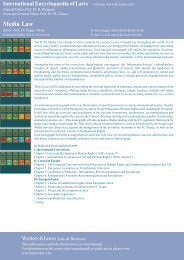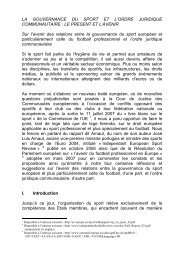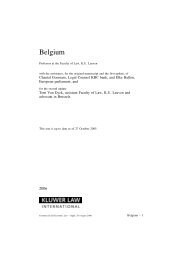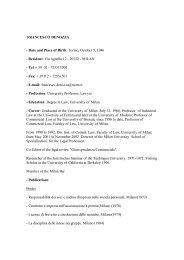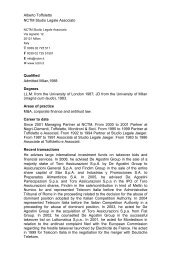USA - International Encyclopaedia of Laws
USA - International Encyclopaedia of Laws
USA - International Encyclopaedia of Laws
Create successful ePaper yourself
Turn your PDF publications into a flip-book with our unique Google optimized e-Paper software.
General Introduction 20–23<strong>of</strong> many matters that could be treated by legislation, and their relative ease <strong>of</strong>amendment and revision. These are, in fact, the characteristics that do distinguishstate constitutions from the federal charter, but these differences do notmake them less constitutional. Rather, these differences reflect a different kind<strong>of</strong> constitution, or constitutions that are unique in the American federal system.There are two differing kinds <strong>of</strong> constitutions, reflecting two distinct constitutionaltraditions.20. State constitutions are usually contrasted with their federal counterpartby characterizing the former as limits on governmental power rather than grants<strong>of</strong> power. When the Union was formed, the states retained almost plenarygovernmental power exercised primarily by their legislatures. This power waslimited only to the extent that the states granted such powers to the federalgovernment, agreed to restrictions on state power in the federal Constitution,or imposed limitations on themselves in their own constitutions. According tothe Supreme Court <strong>of</strong> Kansas: ‘It is fundamental that our state constitution limitsrather than confers powers. Where the constitutionality <strong>of</strong> a statute is involved,the question presented is, therefore, not whether the act is authorized by theconstitution, but whether it is prohibited thereby.’ 11. State ex rel. Schneider v. Kennedy, 587 P.2d 844, 850 (Kan. 1978).21. The focus on the extent <strong>of</strong> legislative powers one encounters in federalconstitutional law is not as prevalent in state constitutional law, which tends t<strong>of</strong>ocus on limits on legislative power. Accordingly, the most important products<strong>of</strong> judicial interpretation <strong>of</strong> the federal Constitution are implied powers, whileat the state level implied limitations are most important.22. The general characterization <strong>of</strong> state constitutions as documents <strong>of</strong>limitation is correct but oversimplified. Many provisions in modern stateconstitutions were adopted to overcome earlier judicial interpretations <strong>of</strong> theconstitution which prohibited the exercise <strong>of</strong> power in question. For example,the New York Constitution authorizes the Legislature to create a system <strong>of</strong>workers’ compensation to take the place <strong>of</strong> the tort liability system forworkplace injuries. This was adopted after a court decision concluding such asystem was in violation <strong>of</strong> the state constitution. Such provisions are grants <strong>of</strong>power, or at least the removal <strong>of</strong> limitations. States also may insert grants <strong>of</strong>power in their constitutions to remove constitutional doubt or to ratifypreexisting practices.23. The texts <strong>of</strong> state constitutions are much more changeable than theirfederal counterpart because they are subject to change from a number <strong>of</strong>different sources, including legislative proposals, initiative amendments, andproposals submitted to the voters by constitutional conventions. Tracing theevolution <strong>of</strong> the text under scrutiny may reveal a number <strong>of</strong> changes over timein the language <strong>of</strong> the provision. Analyzing the changes leading up to thecurrent text may support a specific interpretation. Such changes in the underly-Constitutional Law – Suppl. 34 (October 1999) <strong>USA</strong> (Sub-national) – 15




